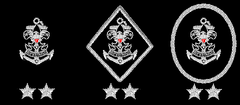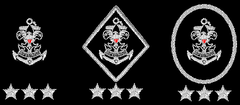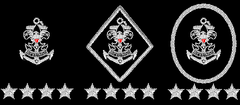- Sea Scouting (Boy Scouts of America)
-
Sea Scouting 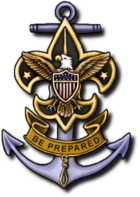
Owner Boy Scouts of America Age range 13 through 21 years[1] Country United States Founded 1912 Founders Arthur A. Carey, Charles T. Longstreth Commodore Charles D. Wurster Boatswain Connor Rieve Previous
Varsity Scouting
Boy ScoutingWebsite
http://seascout.org/Sea Scouting is a part of the Venturing program that the Boy Scouts of America offers for young men and women. Along with Cub Scouting for younger boys and Boy Scouting for older boys, Venturing and Sea Scouting provide a program for religious, fraternal, educational, and other community organizations to use for character, citizenship, and mental and personal fitness training for youth. As part of this training, Sea Scouts are expected to develop personal religious values, learn the principles of American heritage and government, and acquire skills that will prepare them to become successful adults.
Sea Scouting is the BSA's implementation of the Sea Scout program, initially developed in 1910 by Warington Baden-Powell in England. The founders of Sea Scouting in the United States are Arthur A. Carey of Waltham, Massachusetts and Charles T. Longstreth of Philadelphia, Pennsylvania. Both leaders independently established Sea Scout groups in the summer of 1912. This accomplishment was recorded in the inaugural issue of Scouting.
The advancement scheme for Sea Scouts places an initial emphasis on nautical skills before encouraging the youth to take a major role in planning activities in the unit. Young men and women ages fourteen through twenty-one who are willing to abide by the requirements of BSA membership, including agreeing to live by the ideals expressed in the Sea Promise, Scout Oath, and Scout Law are eligible to join a Sea Scouting ship.[2] Ships are administered by volunteers with the assistance and support of some paid professional staff.
Contents
Aims and principles
- Sea Promise
As a Sea Scout, I promise to do my best
To guard against water accidents;
To know the location and proper use of the lifesaving devices on every boat I board;
To be prepared to render aid to those in need and;
To seek to preserve the motto of the sea, "Women and children first."- Mission
To develop, enhance, and expand the Sea Scouts, BSA program in a manner that emphasizes the purposes and achieves the objectives of the Boy Scouts of America, working to help local councils improve their membership and programs.[3]
Sea Scouts also learn and subscribe to the Scout Oath, Scout Law, and Venturing Code.
Organization
The ship is the fundamental unit of Sea Scouting, consisting of five or more Sea Scouts and the adult leaders. Ships are numbered and may adopt a name.
Each ship is sponsored by a community organization such as a business, service organization, private school, labor group or religious institution. The chartered organization is responsible for providing a meeting place and promoting a good program. A chartered organization representative manages the relationship between the ship, the chartered organization, and the BSA.
The ship committee is a group of adults, led by the ship committee chair, who guide the ship program and activities and manage record keeping, finance, leadership recruitment and registration. The ship is led by youths who are elected to the positions of boatswain, boatswain's mate, crew leader, assistant crew leader, yeoman, purser, and storekeeper. Skipper and mate provide guidance while allowing the youth to lead the ship.
Above the ship level, committees which are organized to support the program. Each level also has its own terminology:
- Division (district)
- Squadron (council)
- Flotilla (area)
- Fleet (region)
Uniform and insignia
Individual Ships have traditionally worn US Navy or US Coast Guard uniforms, or a polo-style shirt or T-shirt worn with regular clothes.
The current edition of the Sea Scout Manual (#33239C, 2002), lists and illustrates the current, approved Sea Scout uniforms. The use of these traditional Sea Scout Uniforms (based on modified US Navy uniforms) are mandated for Regional and National events. These uniforms were standardized by Commander Thomas J. Keane, a U.S. Naval Officer, who revamped Sea Scouts in the mid-1920s. Because of a recent (2006) decision made by the U.S. Navy to replace their coverall and work uniforms (the so-called "dungaree" uniforms for enlisted members and "working khaki" for Officers and CPOs) with a non-tactical MARPAT-style camouflage uniform, the non-dress uniforms worn by Sea Scouts and their leaders will eventually take on an "antiquated" appearance.
Youth members wear US Navy enlisted-style uniforms: the so-called "Cracker Jack" uniforms in white or navy blue for formal and semi-formal occasions, and for all other activities, the "dungaree" style work uniform, which is a chambray blue button-up shirt worn with dark blue trousers and a baseball-style cap. To avoid confusion with Naval personnel, changes are made to these uniforms. The center stripe on the cuffs and "tar flap" (the square collar) on the navy "Cracker Jack" uniform is removed and tar flap ornaments, known as "bugs," are sewn on over the stars on both uniforms. In addition, Sea Scout strips are worn over the right breast on all uniforms in a manner similar to the "Boy Scouts of America" strips worn on the Scouting shirts. The 'dixie cup' hat is also worn, sometimes with the dungaree uniform in place of the baseball cap when worn away from Ship functions, with older (pre-2002) covers having a "bug" stitched in the center.
Adults wear US Navy officer-style uniforms: the dress blue, khaki summer work uniform, and summer whites (similar to the US Navy's "tropical white-long" uniform—a short-sleeve white shirt with detachable soft epaulet loops with the adults position embroidered on them, with white trousers, belt and shoes). A white combination cap is worn with blues and whites, with a baseball cap (or the combination cap with a khaki cover) being worn with khakis. The wearing of adult uniforms is optional for those with the Quartermaster rank, but only at the local council and unit level, as the National and Regional officers must wear the "Cracker Jack" uniform. If worn, the uniform is worn in the same manner as that of a Navy Chief Petty Officer.
Insignia are as follows:
- All badges are white on blue for navy blues, adult khaki and dungarees, and blue on white for whites. One does not wear contrasting insignia on the uniforms.
- a patch for the local council the Ship belongs to is worn on the left sleeve,. This is the same patch worn on the Boy Scout and Venturing uniforms.
- Below the local council patch, the Ship numerals are either white or blue. Use of ship's numerals is no longer part of the 'official' uniforms, but many ships continue to wear them for tradition, then the badge of office is worn. Adults in dress blues, and Quartermasters who opt for wearing the adult uniform wear their badge of office 2 inches from the cuff of the sleeve. Below this is worn the Long Cruise patch, with segments in white and red for addition cruises (white=1 additional award, red=5 additional awards).
- On the right sleeve the U.S. Flag patch is worn.
- Below the flag patch, the Ship's identification "crest" is worn. This crest, special to each unit, has the ship's name, number, and location (city & state) on it. This replaces the unit numeral patch on the left sleeve, which was worn prior to 2003, but ship crests have been around since the 1920s. If the Ship has no crest, or the individual works above the Ship level, the generic Sea Scout emblem is worn. Leaders at the flotilla and regional levels (except for the BSA Western Region — they are divided into areas with an Area Sea Scout Committee) wear the Regional emblem of the region they are working in.
- The "Standard Sea Scout Unit" patch, a red and blue patch with white letters, is worn underneath the crest. This is the Sea Scouts equivalent to the Quality Unit.
- Above the left breast pocket, Sea Scouts and leaders can wear up to six square knots or five pin-on medals on the dress blue or white uniforms, with the badge of rank being worn on the pocket itself. No knots are supposed to be worn on the summer tan uniform, though many do. Quartermasters wearing the "Cracker Jack" uniform wear the Quartermaster square knot, a dark blue knot on white background, in place of the rank insignia. The Sea Scout Advanced Leader Trained (SEAL) "double dolphins" pin is worn above the knots.
- Above the right breast "pocket," the distinctive "SEA SCOUTS B.S.A." strip is worn. This strip is available on white, navy blue, khaki, and chambray blue. The nametag being worn above it. The adult Seabadge pin is worn above the nametag.
- On the collar of the adult's khaki uniform, the adult wear "collar marks," showing position of office, in the same manner as that of US Navy officers.
- On the shoulders of adult summer white uniform, black soft shoulder epaulet covers are worn on the shirt's epaulets. These have the position of office embroidered (or use the metal collar marks).
Other notes
- Wearing of Wood Badge beads is not allowed on Sea Scout uniforms. This is due to safety reasons.
- Wearing of Military campaign ribbons and other non-BSA awards are not allowed on Sea Scout uniforms.[4] This is due to avoiding looking like U.S. Navy personnel. However, the Venturing Bronze and Gold ribbons may be worn on the uniform.[5]
- Wearing of OA Lodge flaps is not allowed on Sea Scout uniforms (though some do wear them).
- Those that attend National Scout Jamboree or World Scout Jamboree , especially those staffing the Sea Scout exhibit, will wear one Jamboree patch on their uniforms above the right pocket, at least during the Jamboree.
Adult insignia
Many are confused by the insignia used by adult Sea Scout leaders. The position of the adult is indicated by insignia that uses the Sea Scout Badge (Boy Scout First Class badge superimposed on an anchor), and then a combination of ropes and stars to indicate the position and level.
The level of a Scouter is indicated by the stars.
1 star ( * ) is ship level
2 stars ( ** ) is council level (squadron in Sea Scout terminology)
3 stars ( *** ) is area or region level (flotilla and fleet respectively)
4 stars ( **** ) is National levelThe position of the Scouter at these levels are indicated by either the presence or absence of a rope diamond or rope oval around the Sea Scout emblem. A rope diamond indicates the person is the ship committee chairman (rope diamond with 1 star) or squadron, flotilla, or Fleet commodore (rope diamond with 2, 3, or 4 stars). A rope oval indicates the person is a ship committee member (rope oval with 1 star) or squadron, flotilla, or Fleet vice-commodore/committee member (rope oval with 2, 3, or 4 stars). At the squadron, flotilla, and Fleet levels, the absence of the rope oval or diamond indicates a professional Scouter working at those levels. At the ship level, the Skipper is indicated by a star and bar ( *|) below the Sea Scout badge, while the mate (Skipper's assistant leaders), have just a star (*).
Advancement
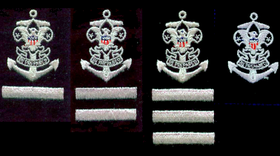
Sea Scout ranks: Apprentice, Ordinary, Able, Quartermaster 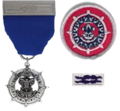
Quartermaster Award
medal, badge and knotThe Sea Scout rank system consists of Apprentice, Ordinary, Able and Quartermaster. The first rank of Apprentice shows basic marlinspike seamanship skills, safety and basic ideals. To earn Ordinary, the Sea Scout must know, the Ideals of Sea Scouting, be an active member for six months, learn specials skills relating to boats, marlinspike seamanship, piloting, communicating, swimming, safety, and cooking. In addition three of seven electives need to be completed such as, close order drill, signaling in semaphore, boxing a compass, yact racing, sailing, ornamental ropework, and engine maintenance. For the Able rank, the Sea Scout must be able to explain and demonstrate a complete knowledge seamanship skills, earn the Lifesaving merit badge, complete a long cruise, and must and be a petty officer in his or her ship.
Quartermaster is the highest rank attainable by a Sea Scout and is equivalent to Eagle Scout (Boy Scouts of America). The Sea Scout must attend at least three quarters of all Ship meetings and special activities over eighteen months, demonstrate marlinspike seamanship and leadership skills, demonstrate the ability to teach Sea Scouting skills, complete a Quartermaster Leadership Service Project (community service project) and pass a council level board of review. The Quartermaster emblem is a medal consisting of the Sea Scout emblem on a ship's wheel that is suspended from a solid dark blue ribbon that is in turn suspended from a bar bearing the design of a double carrick bend knot.
Sea Scouts who earn this rank are entitled to wear a uniform similar to that of a United States Navy Chief Petty Officer (CPO), and can earn advanced rates upon enlistment into the U.S. Navy or United States Coast Guard.
Although not an actual rank, pre-Apprentice members are sometimes referred to as "cabin-boys" or "cabin-girls".
Other awards and recognitions
Sea Scout qualifications 
Small Boat Handler, Qualified Seaman, Long Cruise Badge Sea Scouts currently may earn two seamanship knowledge and skill qualification recognitions: the "Qualified Seaman" and "Small Boat Handler" badges.
Sea Scouts may also obtain the boating licenses and safe boating training certifications offered at the state and local levels and are encouraged to qualify in first aid, CPR, lifesaving, SCUBA and US Sailing certifications. Ships are encouraged to affiliate with the United States Power Squadrons, enabling Sea Scouts and Scouters to obtain the USPS training.
The Long Cruise Badge may be earned by Ordinary rank and above Sea Scouts and adults who complete a two week cruise, or a series of weekend or overnight cruises adding up to 14 days. Segments indicate subsequent awards— white for one additional award and red for five additional awards.
Sea Scouts may earn all Venturing awards, but only registered Sea Scouts may earn Sea Scouting awards. Sea Scouts who have earned the First Class rank in Boy Scouting can work on requirements and merit badges for the rank of Eagle Scout until age 18.
Activities
As a nautical program, most ships engage in several activities in this area, such as sailing trips, scuba dives, and other boating activities. Ships also have to work on maintain their boats and equipment.
Councils with a squadron structure may hold Sea Scout regattas or rendezvous organized among local ships, usually with sailing competitions that may include ships from other councils. Several areas and regions also organize similar events. There is currently no National Sea Scout event, but the biannual William I. Koch International Sea Scout Cup, is an international Sea Scouting event.
Training
Sea Scouts take part in Venturing training with specific Sea Scouting training for youth and adults.
Youth Training
Sea Scout Advanced Leadership
SEAL
Youth may attend the week-long Sea Scout Advanced Leadership Training (SEAL) Upon completion, the double-dolphin SEAL training pin may be worn. Adults who completed SEAL training as a youth or has qualified to be a SEAL course director or assistant course director may also wear the badge.
Adult Training
Sea Scout adults complete the same training as Venturing adults, as well as Sea Scout Leader Specialized Training. Seabadge is the advanced leadership and management course for adults.
See also
References
- ^ (PDF) Boy Scouts of America Youth Application. Boy Scouts of America. #28-406B. http://www.scouting.org/filestore/pdf/28-406.pdf. Retrieved March 10, 2008. "Venturers and Sea Scouts registered in a crew or ship prior to their 21st birthday may continue as members after their 21st birthday until the crew or ship recharters or until they reach their 22nd birthday, whichever comes first."
- ^ Boy Scouts of America Youth Application. Boy Scouts of America. #28-406B. http://www.scouting.org/forms/28-406.pdf. Retrieved October 6, 2007. "Venturers and Sea Scouts registered in a crew or ship prior to their 21st birthday may continue as members after their 21st birthday until the crew or ship recharters or until they reach their 22nd birthday, whichever comes first."
- ^ 4, 2009_Reorganization_memo.pdf "Clarification on recent changes in BSA Organization". http://www.seascout.org/for_leaders/organizational_structure/February 4, 2009_Reorganization_memo.pdf. Retrieved May 17, 2009.[dead link]
- ^ Boy Scouts of America: Sea Scout Manual, page 115. 2002.
- ^ Boy Scouts of America: Sea Scout Manual, page 103. 2002.
External links
- Sea Scouts at the Open Directory Project
- Michael Brown. "A History of Senior Scouting Programs in the BSA". http://www.seniorscoutinghistory.org/. Retrieved November 13, 2006.
Boy Scouts of America Organization Advancement and recognition - Boy Scouting and Varsity Scouting awards
- Eagle Scout
- Honors and awards of the Order of the Arrow
- Merit badge
- Ranks in the Boy Scouts of America
- Venturing and Sea Scouting awards
- Quartermaster Award
- Ranger Award
- Silver Award
- Distinguished service awards
- Distinguished Eagle Scout Award
- Silver Beaver Award
- Silver Antelope Award
- Silver Buffalo Award
- Silver World Award
- Other awards
Leadership training and awards - Introduction to Leadership Skills for Troops
- Introduction to Leadership Skills for Crews
- National Advanced Youth Leadership Experience
- National Youth Leadership Training
- National Youth Leadership Training Leadership Academy
- Kodiak
- Powder Horn
- Scouter's Key Award
- Scouter's Training Award
- Seabadge
- Wood Badge
- Youth Protection program
People Events Other Regions and councils - Central Region
- Southern Region
- Western Region
- Northeast Region
- Abraham Lincoln Council
- Alabama-Florida Council
- Alameda Council
- Alamo Area Council
- Alapaha Area Council
- Allegheny Highlands Council
- Allohak Council
- Aloha Council
- Andrew Jackson Council
- Annawon Council
- Anthony Wayne Area Council
- Arbuckle Area Council
- Atlanta Area Council
- Baden-Powell Council
- Baltimore Area Council
- Bay Area Council
- Bay-Lakes Council
- Black Hills Area Council
- Black Swamp Area Council
- Black Warrior Council
- Blackhawk Area Council
- Blue Grass Council
- Blue Mountain Council
- Blue Ridge Council
- Blue Ridge Mountains Council
- Blue Water Council
- Boston Minuteman Council
- Buckeye Council
- Bucks County Council
- Buckskin Council
- Bucktail Council
- Buffalo Trace Council
- Buffalo Trail Council
- Burlington County Council
- Caddo Area Council
- Calcasieu Area Council
- California Inland Empire Council
- Calumet Council
- Cape Cod and the Islands Council
- Cape Fear Council
- Capitol Area Council
- Cascade Pacific Council
- Catalina Council
- Central Florida Council
- Central Georgia Council
- Central Minnesota Council
- Central New Jersey Council
- Central North Carolina Council
- Central Wyoming Council
- Chattahoochee Council
- Chehaw Council
- Cherokee Area Council (Oklahoma)
- Cherokee Area Council (Tennessee)
- Chester County Council
- Chicago Area Council
- Chickasaw Council
- Chief Cornplanter Council
- Chief Okemos Council
- Chief Seattle Council
- Chippewa Valley Council
- Choctaw Area Council
- Cimarron Council
- Circle Ten Council
- Coastal Carolina Council
- Coastal Empire Council
- Colonial Virginia Council
- Columbia-Montour Council
- Concho Valley Council
- Connecticut Rivers Council
- Connecticut Yankee Council
- Conquistador Council
- Cornhusker Council
- Coronado Area Council
- Cradle of Liberty Council
- Crater Lake Council
- Crossroads of America Council
- Dan Beard Council
- Daniel Boone Council
- Daniel Webster Council
- De Soto Area Council
- Del-Mar-Va Council
- Denver Area Council
- Des Plaines Valley Council
- Direct Service
- East Carolina Council
- East Texas Area Council
- Erie Shores Council
- Evangeline Area Council
- Far East Council
- Five Rivers Council
- Flint River Council
- French Creek Council
- Gamehaven Council
- Gateway Area Council
- Georgia-Carolina Council
- Gerald R. Ford Council
- Glacier's Edge Council
- Golden Empire Council
- Golden Spread Council
- Grand Canyon Council
- Grand Columbia Council
- Grand Teton Council
- Great Alaska Council
- Great Lakes Council
- Great Rivers Council
- Great Salt Lake Council
- Great Sauk Trail Council
- Great Smoky Mountain Council
- Great Southwest Council
- Great Trail Council
- Greater Alabama Council
- Greater Cleveland Council
- Greater New York Councils
- Greater Niagara Frontier Council
- Greater Saint Louis Area Council
- Greater Western Reserve Council
- Greater Yosemite Council
- Green Mountain Council
- Greenwich Council
- Gulf Coast Council
- Gulf Ridge Council
- Gulf Stream Council
- Hawk Mountain Council
- Hawkeye Area Council
- Heart of America Council
- Heart of Ohio Council
- Heart of Virginia Council
- Hiawathaland Council
- Hoosier Trails Council
- Housatonic Council
- Hudson Valley Council
- Illowa Council
- Indian Nations Council
- Indian Waters Council
- Inland Northwest Council
- Iroquois Trail Council
- Istrouma Area Council
- Jayhawk Area Council
- Jersey Shore Council
- Juniata Valley Council
- Katahdin Area Council
- Knox Trail Council
- La Salle Council
- Lake Huron Area Council
- Las Vegas Area Council
- Last Frontier Council
- Laurel Highlands Council
- Lewis and Clark Council
- Lincoln Heritage Council
- Lincoln Trails Council
- Long Beach Area Council
- Longhorn Council
- Longhouse Council
- Longs Peak Council
- Los Angeles Area Council
- Los Padres Council
- Louisiana Purchase Council
- Marin Council
- Mason-Dixon Council
- Maui County Council
- Mecklenburg County Council
- Miami Valley Council
- Mid-America Council
- Mid-Iowa Council
- Middle Tennessee Council
- Midnight Sun Council
- Milwaukee County Council
- Minsi Trails Council
- Mississippi Valley Council
- Mobile Area Council
- Mohegan Council
- Monmouth Council
- Montana Council
- Monterey Bay Area Council
- Moraine Trails Council
- Mount Baker Council
- Mount Diablo Silverado Council
- Mountaineer Area Council
- Muskingum Valley Council
- Narragansett Council
- Nashua Valley Council
- National Capital Area Council
- NeTseO Trails Council
- Nevada Area Council
- New Birth of Freedom Council
- North Florida Council
- Northeast Georgia Council
- Northeast Illinois Council
- Northeast Iowa Council
- Northeastern Pennsylvania Council
- Northern Lights Council
- Northern New Jersey Council
- Northern Star Council
- Northwest Georgia Council
- Northwest Suburban Council
- Northwest Texas Council
- Norwela Council
- Occoneechee Council
- Ohio River Valley Council
- Okefenokee Area Council
- Old Colony Council
- Old Hickory Council
- Old North State Council
- Orange County Council
- Ore-Ida Council
- Oregon Trail Council
- Otschodela Council
- Ouachita Area Council
- Overland Trails Council
- Ozark Trails Council
- Pacific Harbors Council
- Pacific Skyline Council
- Palmetto Area Council
- Patriots' Path Council
- Pee Dee Area Council
- Pennsylvania Dutch Council
- Piedmont Council (California)
- Piedmont Council (North Carolina)
- Pikes Peak Council
- Pine Burr Area Council
- Pine Tree Council
- Pony Express Council
- Potawatomi Area Council
- Potomac Council
- Prairielands Council
- Puerto Rico Council
- Pushmataha Area Council
- Quapaw Area Council
- Quivira Council
- Rainbow Council
- Redwood Empire Council
- Revolutionary Trails Council
- Rio Grande Council
- Rip Van Winkle Council
- Rocky Mountain Council
- Sagamore Council
- Sam Houston Area Council
- Samoset Council
- San Diego-Imperial Council
- San Francisco Bay Area Council
- San Gabriel Valley Council
- Santa Clara County Council
- Santa Fe Trail Council
- Scenic Trails Council
- Seneca Waterways Council
- Sequoia Council
- Sequoyah Council
- Shawnee Trails Council
- Shenandoah Area Council
- Simon Kenton Council
- Sioux Council
- Snake River Council
- South Florida Council
- South Plains Council
- South Texas Council
- Southeast Louisiana Council
- Southern New Jersey Council
- Southern Sierra Council
- Southwest Florida Council
- Southwest Michigan Council
- Stonewall Jackson Area Council
- Suffolk County Council
- Susquehanna Council
- Suwannee River Area Council
- Tall Pine Council
- Tecumseh Council
- Texas Trails Council
- Theodore Roosevelt Council
- Three Fires Council
- Three Harbors Council
- Three Rivers Council
- Tidewater Council
- Transatlantic Council
- Trapper Trails Council
- Tri-State Area Council
- Tukabatchee Area Council
- Tuscarora Council
- Twin Rivers Council
- Twin Valley Council
- Utah National Parks Council
- Ventura County Council
- Verdugo Hills Council
- Virgin Islands Council
- Voyageurs Area Council
- W. D. Boyce Council
- West Central Florida Council
- West Tennessee Area Council
- Westark Area Council
- Westchester-Putnam Council
- Western Colorado Council
- Western Los Angeles County Council
- Western Massachusetts Council
- Westmoreland-Fayette Council
- Winnebago Council
- Yankee Clipper Council
- Yocona Area Council
- Yucca Council
 Scouting and Guiding topics
Scouting and Guiding topics 
The Scouting Movement Sections Founders, pioneers, and notable leaders Prominent places International Scouting - Confédération Européenne de Scoutisme
- International Scout and Guide Fellowship
- Order of World Scouts
- Scouts-in-Exile
- International Union of Guides and Scouts of Europe
- World Association of Girl Guides and Girl Scouts
- World Federation of Independent Scouts
- World Organization of the Scout Movement
Other Categories:- Boy Scouts of America
- 1912 establishments in the United States
Wikimedia Foundation. 2010.



